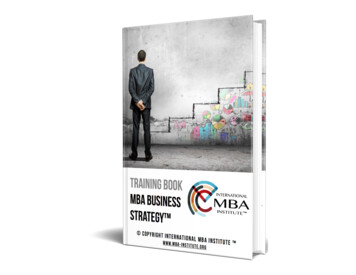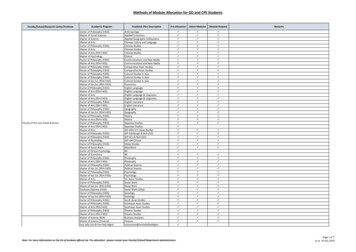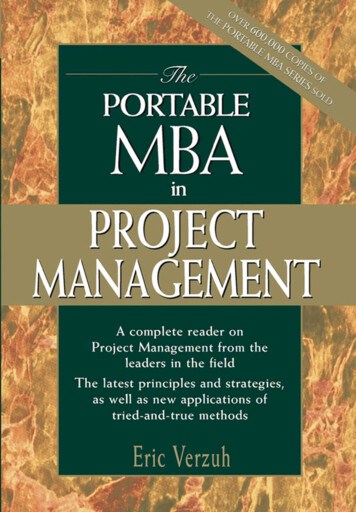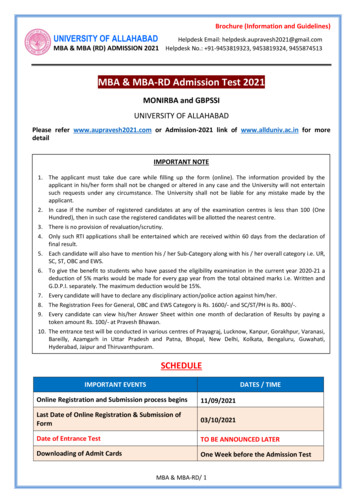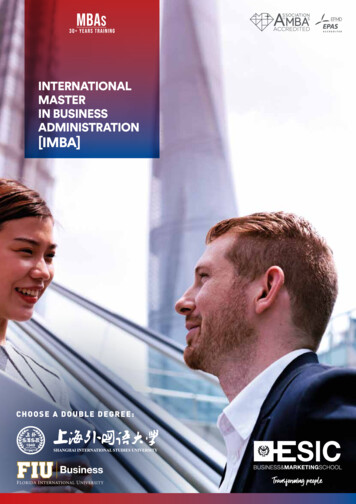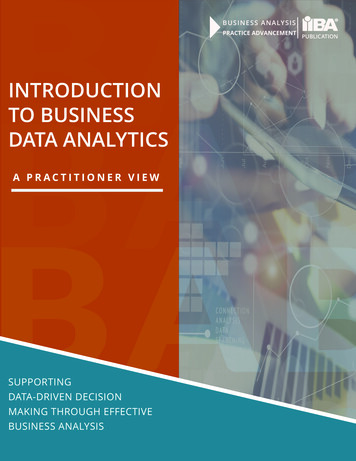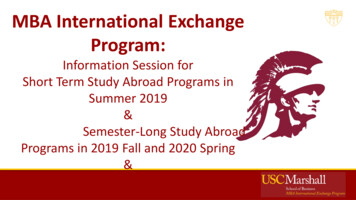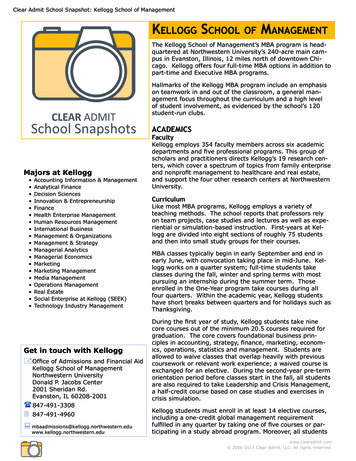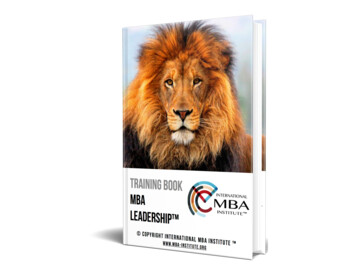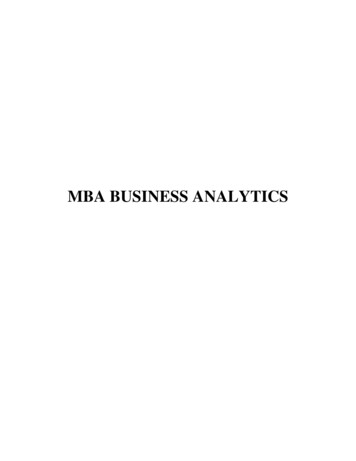
Transcription
MBA BUSINESS ANALYTICS
MBABUSINESS ANALYTICSCurriculum and Syllabus(Based on Choice Based Credit System)Effective from the Academic year2018-2019Department of M.B.ASchool of Management Studies
VISTAS MBA Program OutcomesThe following outcomes have been identified by the School of Management and commerce, Faculty Council, asimportant for students to be able to perform at the conclusion of the MBA program. The MBA curriculum has beenmapped to these outcomes, which are regularly assessed to identify levels of student achievement and areas ofimprovement. Students who are Graduates of the Master of Business Administration degree program will be ableto:1. Apply knowledge of management techniques in business environment2. Evaluate the systems and processes used in an organization including the planning, decision-making, groupdynamics, innovation, production, supply chain, operations, technologies, marketing and distribution management.3. Design alternatives to solve business problems utilizing quantitative analysis, critical thinking and sound ethicaldecision making.4. Use research based knowledge and methods including company analysis, primary and secondary data collection,analysis and interpretation of data to find solution to business problems5. Demonstrate effectively on analysing, interpreting and solving problems in developing business projects usingappropriate tools and techniques.6. Apply economic models, accounting principles, statistical techniques, and financial theories, analysis, andreporting in business decision-making.7. Organize tools and techniques from Various Functional areas(i.e Finance , Marketing, Human Resources,operations etc) to handle business problems.8. Evaluate and combine ethical considerations in making business decisions9. Communicate effectively in various forms by effective use of recent technology and logical reasoning forpresentations, documentation, report writing ,manual preparation .10. Adapt life-long learning and professional development to enrich knowledge and competencies11. Perceive an aptitude for creativity, innovation and entrepreneurship.12. Demonstrate a global outlook with ability to identify aspects of the global business operations.
MBABUSINESS ANALYTICSProgram Specific OutcomesPSO – 1:Apply knowledge of management techniques in business environment.PSO – 2:Design predictive and descriptive analysis on the basis of data.PSO – 3: Evaluate the systems and processes used in an organization including the planning,decision-making, group dynamics, innovation, production, supply chain, operations, technologies,marketing and distribution management.PSO – 4: Design alternatives to solve business problems utilizing quantitative analysis, criticalthinking and sound ethical decision making.PSO – 5: Use research based knowledge and methods including company analysis, primary andsecondary data collection, analysis and interpretation of data to find solution to business problems.PSO – 6: Organise and critically apply the concepts and methods of business analytics.PSO – 7: Interpret data using latest data analytics tools to address organisational problem.PSO – 8: Demonstrate a global outlook with ability to identify aspects of the global businessoperations.PSO – 9: Interpret data using latest data analytics tools to address organisational problem.PSO – 10: Summarise, process and transform data for obtaining meaningful conclusions.PSO – 11: Communicate effectively in various forms by effective use of recent technology andlogical reasoning for presentations, documentation, report writing, manual preparation.PSO – 12: Adapt life-long learning and professional development to enrich knowledge andcompetencies.
VISTASSCHOOL OF MANAGEMENT STUDIESBOARD OF STUDIES MEMBERSMBA (GEN), MBA (LSM), MBA (LSCM) and MBA (BA)Sl.No1.2.3.4.5.6.7.8.9.10.Name & AddressDr.P.R. Ramakrishnan,Dean, School of Management Studies,VISTAS, Chennai-600117Dr.R.Thenmozhi,Professor and Head,Department of Management Studies,Madras University, ChennaiMr.K.V.V.GiriPresident CCHA,M/S Vaishnavi freight logistics Pvt ltd.Mrs.Sripriya,Operations Programme Manager, TCSDr.S.Vasantha ,Professor, School of Management e Professor,School of Management Studies,VISTAS,Chennai-600117Dr.G.RajiniAssociate Professor,School of Management Studies,VISTAS,Chennai-600117Dr.P.ShaliniAssociate Professor, School of Management stant Professor, School of Management nt Professor, School of Management nExternal ExpertExternal ExpertAlumniInternal MemberInternal MemberInternal MemberInternal MemberInternal MemberInternal Member
VISTASDEGREE OF MASTER OF BUSINESS ADMINISTRATIONMBABUSINESS ANALYTICSCHOICE BASED CREDIT SYSTEMREGULATIONSw.e.f. 20181. ELIGIBILITY FOR THE AWARD OF DEGREE:A candidate shall be eligible for the award of the Degree only if he/she has satisfactorilyundergone the prescribed Course of Study in a College affiliated to this University for a period ofnot less than TWO academic years and, passed the examinations of all the FOUR Semesters.2. DURATION OF THE COURSE:The course for FULL-TIME students shall extend over a period of TWO academic yearsconsisting of FOUR Semesters. Each academic year shall be divided into Two Semesters. TheFIRST academic year shall comprise the First & Second Semesters, the SECOND academic yearthe Third & Fourth Semesters.The ODD Semesters shall consist of the period from July to November of each year andtheEVEN Semesters from January to April of each year.The duration of each semester will be about 16 weeks. The subjects of study shall be inaccordance with the syllabus prescribed from time to time which may be amended through a boardof studies members.CONDITIONS FOR ADMISSION:Candidates shall be required to have passed any Bachelor's Degree of anyUniversity/Institute of college or of any other University or a qualification accepted by theSyndicate of this University as equivalent thereto, shall be eligible for admission to MBA DegreeCourse.
3.1. COURSE OF STUDY AND SCHEME OF EXAMINATIONS (FULL TIME)The total number of subjects of study shall be 25 out of which 17 shall be compulsorysubjects and of the remaining 8 will be Electives, Internship after Second semester and ProjectWork in the Final Semester with a Viva-voce.The FULL-TIME candidates shall take 8 subjects (Theory) in the First semester, 8 subjects(Theory) in the Second Semester, 9 subjects (Theory) in the Third Semester and a SummerInternship and a Project Work.3.2. ELECTIVE SUBJECTS:To offer Elective Subjects to the students, a Minimum enrolment in the Elective Subjectsshall be TEN.PROJECT REPORT & VIVA VOCE:The Project Report must be submitted through the Supervisor and the Head of theDepartment at the end of the final semester ie following the third semester Examination failingwhich the candidate will be treated as appearing on a second occasion and shall NOT BEELIGIBLE for First Class and Ranking.MBA – BUSINESS ANALYTICSSEMESTER ICodeHour / WeekCourseCreditsLecture Tutorial 8CMBN1618PMBN1118PMBN1218PMBN13Management Principles &Organisational BehaviourBusiness StatisticsManagerial EconomicsFinancial Reporting , Statements &AnalysisLegal & Business EnvironmentBusiness CommunicationDatabase Management System & SQLEmerging Areas of Business AnalyticsMini Project400434100044310444000000000022244111
18PMBN14Community Development Project /MOOC / Outbound ExperentialLearning Programme0021222828SEMESTER BN2618CMBN2718PMBN2118PMBN2218IMBN21Hour / WeekCourseOperations ManagementHuman Resources ManagementResearch MethodologyMarketing ManagementQuantitative TechniquesBusiness IntelligenceData Cleaning, Normalisation & DataMiningSpreadsheet ModellingFoundation course in BusinessAnalytics (Cognos STER IIICode18EMBN .18EMBN .18EMBN .18EMBN .18EMBN .18EMBN .18EMBN .18EMBN .18PMBN31CourseElective IElective IIElective IIIElective IVElective VElective VIElective VIIElective VIIIFoundation Course on PredictiveAnalysis(IBM SPSS*)Hour / 00002Credits333333331
18PMBN3218PMBN33Foundation Course in DescriptiveAnalysis(IBM)*Foundation course in Big data andHadoop00210021240627SEMESTER IVCodeHour / WeekCourse18PMBN41 Project WorkFoundation Course in Big dataAnalytics (IBM Infosphere Big 02211Total: 102Internship: The students have to undergo an Internship for thirty days in between secondand third semester. The maximum marks for Internship will be 100. The Internship will beevaluated through Viva voce Exam by the guide and an External expert.Project: The students will do a Project work for Four months in the Fourth Semester. TheMaximum marks for Project Work will be 300. The project Work will be evaluated through Vivavoce Exam by the guide and an External expert. The components of Project Work will be 100marks for Dissertation and 200marks for Viva voce.ELECTIVE MBN0818EMBN0918EMBN1018EMBN11COURSESAdvanced Research Methods and Predictive AnalysisBusiness Optimization and Big Data AnalyticsData Science using R ProgrammingSupply Chain AnalyticsHR AnalyticsMarketing and Retail AnalyticsSocial and Web AnalyticsHealthcare AnalyticsPricing Analytics for Revenue ManagementData Visualization for ManagersStochastic Modeling
ship18EMBN3418EMBN35COURSESSimulation ModelingData Mining for Business decisionsTime Series AnalysisOperations Research ApplicationsQuality Toolkit for ManagersEconomic Analysis and Decision MakingBusiness ForecastingBusiness StrategyE-Commerce and Digital MarketsE-BusinessSAP FICOSAP SDSAP MMSAP HCMManaging Software ProjectsDigital Innovation and TransformationModeling Techniques and IT for Operations ManagementData SecurityCloud ComputingIT ConsultingEnvironmental StudiesIndian Ethos and Business EthicsEthical and Legal Aspects of AnalyticsE-Governance & Cyber Law4. REQUIREMENTS FOR PROCEEDING TO SUBSEQUENT SEMESTER:a. Candidates shall register their names for the First Semester Examination after theadmission in PG Courses.b. Candidates shall be permitted to proceed from, the First Semester up to Final Semesterirrespective of their failure in any of the Semester Examination subject to the condition thatthe candidates should register for all the arrears subjects of earlier semester along with current(subsequent) Semester subjects.c. Students appearing for the University examinations must have a minimum of 75%attendance, failing which will not be permitted to write the examinations.
d. However, the University may condone he attendance shortage of 10% after collecting acondonation fee from the students who have secured 65 to 74% of attendance.e. The students who have secured less than 65% attendance are not eligible to write therespective semester examination. He / She has to rejoin and re-do the respective semestercourse in the next academic year by paying the prescribed tuition fee.f. Condonation for deficiency of attendance will not be granted as a matter of routine.5. EXAMINATIONS:There shall be four examinations, first semester examination will be held in Nov/Dec ofthe first year and the second semester examination at April/May of the first year. Similarly thethird and fourth semester examinations will be held during Nov/Dec and April/May of the secondyear respectively. Max. no. of attempts is 8.6. PASSING MINIMUM:i.A candidate who secures not less than 50 percent marks in the External WrittenExamination and the aggregate (i.e. Written Examination Marks and the InternalAssessment Marks put together) respectively of each paper shall be declared to have passedthe examination in that subject.ii.a. A candidate shall be declared to have passed Project Work andViva-Vocerespectively, if he/she secures a minimum 50 percent marks in the Project WorkEvaluation and the Viva Voce respectively.b. A candidate failing in any subject will be permitted to appear for the examinations againon a subsequent occasion without putting in any additional attendance.c. A candidate who fails in either Project Work or Viva-Voce shall be permitted to redothe Project Work for evaluation and reappear for the Viva-Voce on a subsequentoccasion, if so recommended by the Examiners.iii. A Candidate who successfully completes the course and passes the examinations of all theFOUR Semesters prescribed as per Scheme of Examinations earning prescribed CREDITSshall be declared to have qualified for the Degree, provided the whole course has been
completed within a maximum of 4 YEARS from the date of initially joining the course inthe case of a FULL-TIME candidates.7. CLASSIFICATION OF SUCCESSFUL CANDIDATES:Successful candidates securing not less than 60 percent in the aggregate of the marksprescribed for the Course shall be declared to have qualified for the Degree in First Class, providedthey have passed the Project Work and the Viva-Voce at the FIRST appearance and theExamination of all the other subjects within TWO YEARS after their admission in the case ofFULL-TIME students.Successful candidates securing not less than 75 percent in the aggregate of the marksprescribed for the Course shall be declared to have qualified for the Degree in First Class withDistinction provided they pass all the examinations prescribed for the course at the FirstAppearance / instance.All other successful candidates shall be declared to have passedreexamination in the Second Class.8. GRADING SYSTEMThe following table gives the marks, grade points, letter grades and classification toindicate the performance of the candidate.Conversion of Marks to Grade Points and Letter Grade(Performance in a Paper /Course)MarksGrade PointsGradeDescription90-10010OOUTSTANDING85-899A EXCELLENT80-848AVERY GOOD75-797.5B GOOD70-747BABOVE AVERAGE60-696CAVERAGE50-595DMINIMUM FOR PASS00 - 490RAREAPPEARAAAABSENT-
Calculation of GPA & CGPAGPA (C X GP) / (C)CGPA in 1 (Ci X GPi ) / in 1(Ci)n Number of subjectsC Credit for the academic courses successfully completedGP Grade point for the courses successfully completedGPA Grade point average for all the courses successfully completed in the currentsemester examinationCGPA Cumulative grade point averageOverall Performance:CGPAGradeClass5.00 - 5.99DSecond Class6.00 - 6.99C7.00 - 7.49B7.50 - 7.99B 8.00 - 8.49A8.50 - 8.99A 9.00 - 10.0OFirst ClassFirst Class with DistinctionFirst Class - Outstanding*The candidates who have passed in the first appearance and within the prescribed semester ofthe PG Programme (Core, Elective, Non-major Electives and Extra-Disciplinary courses alone)are eligible.9. RANKING:Candidateswhopassalltheexaminations prescribedfortheCourseIn the FIRST APPEARANCE ITSELF ALONE are eligible for Ranking/Distinction provided inthe case of Candidates who pass all the examinations prescribed for the Course with a break in the
First Appearance due to the reasons as furnished in the Regulations under REQUIREMENTS FORPROCEEDING TO SUBSEQUENT SEMESTER are only eligible for Classification.10. QUESTION PAPER PATTERNTotal Marks for each subject 100 MarksUniversity Exam 60 MarksInternal Assessment 40 MarksDuration: 3 Hours Max. Marks: 100Part A : 8 out of 10 questions( 8 X 5 40 )Part B : 4out of 6 questions( 4 X 10 40 )Part C :1 Case Study or Problem is Compulsory ( 1 X 20 20 )
MBA – BUSINESS ANALYTICSSEMESTER ICodeHour / WeekCourseCreditsLecture Tutorial 8CMBN1618PMBN1118PMBN1218PMBN1318PMBN14Management Principles &Organisational BehaviourBusiness StatisticsManagerial EconomicsFinancial Reporting , Statements &AnalysisLegal & Business EnvironmentBusiness CommunicationDatabase Management System & SQLEmerging Areas of Business AnalyticsMini ProjectCommunity Development Project /MOOC / Outbound ExperentialLearning 22828SEMESTER BN2618CMBN2718PMBN2118PMBN2218IMBN21Hour / WeekCourseOperations ManagementHuman Resources ManagementResearch MethodologyMarketing ManagementQuantitative TechniquesBusiness IntelligenceData Cleaning, Normalisation & DataMiningSpreadsheet ModellingFoundation course in BusinessAnalytics (Cognos 010Practical0000004444444004002100210270104636
SEMESTER IIICode18EMBN .18EMBN .18EMBN .18EMBN .18EMBN .18EMBN .18EMBN .18EMBN .18PMBN3118PMBN3218PMBN33Hour / WeekCourseElective IElective IIElective IIIElective IVElective VElective VIElective VIIElective VIIIFoundation Course on PredictiveAnalysis(IBM SPSS*)Foundation Course in DescriptiveAnalysis(IBM)*Foundation course in Big data ctical0000000033333333002100210021240627SEMESTER IVCodeCourse18PMBN41 Project WorkFoundation Course in Big dataAnalytics (IBM Infosphere Big Insight)Hour / 0Total: 102
ELECTIVE neurship18EMBN3418EMBN35COURSESAdvanced Research Methods and Predictive AnalysisBusiness Optimization and Big Data AnalyticsData Science using R ProgrammingSupply Chain AnalyticsHR AnalyticsMarketing and Retail AnalyticsSocial and Web AnalyticsHealthcare AnalyticsPricing Analytics for Revenue ManagementData Visualization for ManagersStochastic ModelingSimulation ModelingData Mining for Business decisionsTime Series AnalysisOperations Research ApplicationsQuality Toolkit for ManagersEconomic Analysis and Decision MakingBusiness ForecastingBusiness StrategyE-Commerce and Digital MarketsE-BusinessSAP FICOSAP SDSAP MMSAP HCMManaging Software ProjectsDigital Innovation and TransformationModeling Techniques and IT for Operations ManagementData SecurityCloud ComputingIT ConsultingEnvironmental StudiesIndian Ethos and Business EthicsEthical and Legal Aspects of AnalyticsE-Governance & Cyber Law
SEMESTER I
18CMBN11MANAGEMENT PRINCIPLES AND ORGANIZATIONALBEHAVIOUR4004COURSE OBJECTIVE: To describe the fundamentals of Management, significance, scope of management, levels ofmanager, functions of a manger and basics of organizational behavior. To discuss the development of management thought To examine and analyze the behavior of individuals and groups in organizations byunderstanding the concepts of learning, attitudes & perceptions. To understand about the organizational structure, its types, decentralization and delegation ofthe authority.COURSE OUTCOMES:At the end of the course, the students will be able to:CO – 1: Discuss about the management and its historical development.CO – 2: Assess the fundamentals of organizational behavior and OB Model.CO – 3: Analyze the behavior of individuals and groups in organizationsCO – 4: Summarize the perceptions, learning, attitudes, and motivation in organizationsCO – 5: Analyze the teams and organizations, evaluating transaction analysis.CO – 6: Compare and contrast power and influence of leadershipCO – 7: Assess the knowledge about the organization structure and its typesCO – 8: Describe about the line and staff authority.CO – 9: Demonstrate the dynamics of organizational change.CO – 10: Identify the major issues in business ethics and corporate social responsibility.UNIT IINTRODUCTION TO MANAGEMENT12Introduction to Management and Organizational Behavior: Concept of Management, ApplyingManagement theory in practice, Evolution of management thought, Management process andFunctions – Managerial Roles – OB Model – Contributing disciplines of OB – MBOUNIT IIINDIVIDUAL PROCESS IN ORGANIZATIONS12Individual Processes in Organizations: Foundations for Individual Behavior – Learning - Attitudesand Job satisfaction – Personality and values – Perception - Motivation and Organizationalperformance. Contemporary theories of motivation.
UNIT IIIINTERPERSONAL PROCESS IN ORGANIZATIONS12Interpersonal process in Organizations: -Communication Process -Methods – Barriers -Grapevine.Transactional Analysis. Group Dynamics: Typology of Groups -Conflicts in groups - LeadershipModels and Concepts – leadership theories – Decision making and negotiation - Power and Politics.UNIT IVORGANISATIONAL PROCESS12Organizational Process and Characteristics: Dimensions of Organization structure – Authority,Responsibility, and Accountability – Delegation – Centralization, Decentralization – Line and StaffRelationship.UNIT VORGANIZATIONAL DEVELOPMENT12Organizational Development: Resistance to Change - Organizational change - Organizationaldevelopment – Stress management – Business ethics and corporate social Responsibility.TOTAL: 60 HOURSTEXT BOOKS:1. Harold Koontz & Heinz Weihrich, “Essentials of Management”, TMH, 10th Edition, 2007.REFERENCE BOOKS:1. Michael A. Hitt, J. Stewart Black, and Lyman W. Porter, Management, Pearson, 11th Edition,2011.2. Koontz &Weirich, Essentials of Management, Tata McGraw Hill Publishing Company, NewDelhi. Stoner, Freeman & Gilbert, Management, PHI, 6th Edition.3. Robbins.S.P. Fundamentals of Management, Pearson, 2003. Robbins.S. OrganisationalBehaviour, X edn., Prentice-Hall, India.
18CMBN12BUSINESS STATISTICS3104COURSE OBJECTIVE: To impart knowledge of basic statistical tools & techniques with emphasis on their applicationin Business decision process and Management. To focus on more practical than theoretical. To do statistical analysis informs the judgment of the ultimate decision-maker—rather thanreplaces it—some key conceptual underpinnings of statistical analysis will be covered toinsure the understandability of its proper usage.COURSE OUTCOMES:At the end of the course, the students will be able to:CO – 1: Facilitate Objective Solutions in Business Decision Making.CO – 2: Enhance Knowledge in Probability Theory.CO – 3: Describe Normality and its Distribution Concepts.CO – 4: Stress The Need For Collection Of Data and its Dispersion Techniques.CO – 5: Apply Time Series Analysis in Market Prediction Rates.CO – 6: Draw Conclusions over the Hypothetical Situations.CO – 7: Draw Conclusions over the Hypothetical Situations.CO – 8: Measure the trend setting factors for projection of Sales and Demand Curves.CO – 9: Extract the variance among the factors of study concerned.CO – 10: Classify the distribution of Data Spread.UNIT IINTRODUCTION12Introduction to Statistics - Collection of Data - Measures of Central Tendency & Dispersion inFrequency DistributionUNIT IIPROBABILITY THEORY12Probability Theory – Addition, Multiplication & Baye’s Theorem, Test for Normality.UNIT IIICORRELATION12Correlation-Karl Pearson’s and Rank Correlation, Regression (linear)UNIT IVHYPOTHESIS TESTING12Hypothesis Testing –Test for Single Mean& Two Mean– Chi-Square test, F test – ANOVA.UNIT VTESTS12
Index Nos-Unweighted and Weighted-Test of Consistency, Time Series Analysis-Measurement ofSecular Trend-Seasonal VariationsTOTAL: 60 HOURSTEXT BOOKS:1. R.S.N. Pillai, V. Bagavathi,” Statistics”, S.Chand Limited, 7th Ed,20082. N.D. Vohra, “Business Statistics”, Tata McGraw-Hill Education, 2nd Ed,20133. G. V. Shenoy, Uma K. Srivastava, S. C. Sharma,” Business Statistics”, New AgeInternational,2nd Ed, 20054. Beri, ”Business Statistics” Tata McGraw Hill,2nd Ed,2009REFERENCE BOOKS:1. Keller. G,”Statistics for Management”, Cengage Learning, 1st Ed, 2009.2. J. K Sharma, “Business Statistics”, Pearson, 2nd Ed, 2010.3. Arora PN &others,” Complete Statistical Methods”, S. Chand, 3rd Ed, 2010
18CMBN13MANAGERIAL ECONOMICS4004COURSE OBJECTIVE: The study the concept of Managerial Economics by applying a series of basic economicsprinciples. To gain knowledge on issues related to optimal pricing strategies, demand forecasting, andoptimal financing, appropriate hiring decisions, and investment decisions, among others, canbe successfully tackled with managerial economics tools. To analyse how to incorporate a global perspective to their managerial economics box oftools.COURSE OUTCOMES:At the end of the course, the students will be able to:CO – 1: Define the basic elements of managerial economics aspects of the firm.CO – 2: Study the life cycle of a productCO – 3: Forecast demand for a product and decide on the demand decisions.CO – 4: Know what to produce, where to, when to, how to, for whom to.CO – 5: Frame policy for production to minimize the cost and maximum the profit.CO – 6: Construct the cost function.CO – 7: Reorganise the basics of market structures and their environment.CO – 8: Decide on the input and output decisions.CO – 9: Know the basic theories related to business practices.CO – 10: Enable them to take a decision with given business situationUNIT IINTRODUCTION12Introduction to Managerial Economics – Nature and scope of macroeconomics -Incremental principle– equimarginal principle – some decision rules – The risk and uncertainty theory –optimizationtechniques – Baumol’s sales maximization – least-cost combination.UNIT IIDEMAND DECISIONS12Demand Decisions – Demand analysis – elasticity of demand – demand forecasting – types &methods of demand forecasting – trend projection method – least square method of demandforecasting limitations & usesUNIT IIIOUTPUT DECISIONS12
Input-Output Decisions - Production function – Cost and managerial decision making – CobbDouglas production functions – Law of variable proportion – short run cost output – long run costoutput – economies and dimensions of scale of production.UNIT IVPRICE-OUTPUT DECISIONS12Price-Output Decisions - Market Environment of Price Output Decisions by the Firm and the Industry– Pricing under perfect competition – digopoly pricing strategies and tactics – pricing – pricing inlife-cycle of a product -Profit-Maximization & Competitive Markets-Price-Searchers, Cartels,Oligopoly-Advanced Pricing and Auctions.UNIT VECONOMIC THEORY12The Firm in Theory and Practice - Economic Theory of the Firm – The Behavioral Theory of theFirm - Managerial Theories of the Firm – Profit concepts & analysis – Game Theory and AsymmetricInformation.TOTAL: 60 HOURSTEXT BOOKS:1. Dean Joel, Managerial Economics, PHI, New Delhi, 1976, First Edition2. Douglas Evan J, Managerial Economics, Theory, Practice & Problems; PHF, New Delhi;1983, First EditionREFERENCE BOOKS:1. K.K. Seo, Managerial Economics, Richard D. Irwin Inc. 19882. I.C. Dhingra, Essentials of Managerial Economics - Theory, Applications and Cases SultanChand, New Delhi, 2003
18CMBN14FINANCIAL REPORTING, STATEMENTS & ANALYSIS3104COURSE OBJECTIVE: To think in a new and more creative way when analyzing or forecasting financial information. To introduce new tools common to financial statement analysis and how to use them inpractical applications. To understand how financial statement information can help solve business problems andincrease the ability to read and understand financial statements and related information.COURSE OUTCOMES:At the end of the course, the students will be able to:CO – 1: State the importance of common accounting standardsCO – 2: Outline the accounting processCO – 3: Prepare financial statements through ratio analysis.CO – 4: Analyze financial reports of financial instruments, mutual funds,CO – 5: Prepare cash flow and fund flow statementCO – 6: Analyze cash flow and fund flow statementCO – 7: Calculate cost of capital – Debt, Equity, Preference Capital.CO – 8: Identify various sources of FinanceCO – 9: Estimate work capital of an organization.CO – 10: Estimate components of work capital.UNIT IINTRODUCTION12Introduction to Management Accounting-Need and Importance –– Accounting concepts &conventions – Accounting Standards - Overview of IFRS and GAAP. Mechanics of Accounting:Double entry system of accounting, journalizing of transactions; ledger posting and trial balance,preparation of final accounts, Profit & Loss Account, Balance Sheet.UNIT IIANALYSIS OF FINANCIAL STATEMENTS12Analysis of financial statement: Ratio Analysis- solvency ratios, profitability ratios, activity ratios,liquidity ratios, market capitalization ratios; Common Size Statement; Comparative Balance Sheetand Trend Analysis of manufacturing, service & banking organizations.UNIT IIIFUNDS FLOW AND CASH FLOW ANALYSIS12
Fund Flow Analysis: Meaning – uses – Preparation of Fund Flow Statement. Cash Flow Analysis (asper Accounting Standard 3): Meaning – uses – Preparation of Cash Flow Statement.UNIT IVCAPITAL BUDGETING AND MARGINAL COSTING12Capital budgeting – meaning –steps – different types of investment decisions - Different methods –Payback, Net Present Value, Internal rate of return, Profitability index, Average rate of return –Capital rationing Marginal costing – Cost Volume Profit analysis – Break Even analysis –Applications of marginal costingUNIT VBUDGETING AND FINANCIAL REPORTING12Budgeting – Different types of budgeting – Cash budget – Flexible budget.Financial reporting –Concepts – users, Objectives of financial reporting – Qualitative characteristicsof information in financial reporting – basic problems of disclosure – Role of SEBI in IFRS –Statutory disclosures in
3. Design alternatives to solve business problems utilizing quantitative analysis, critical thinking and sound ethical decision making. 4. Use research based knowledge and methods including company analysis, primary and secondary data collection, analysis and interpretation of data
